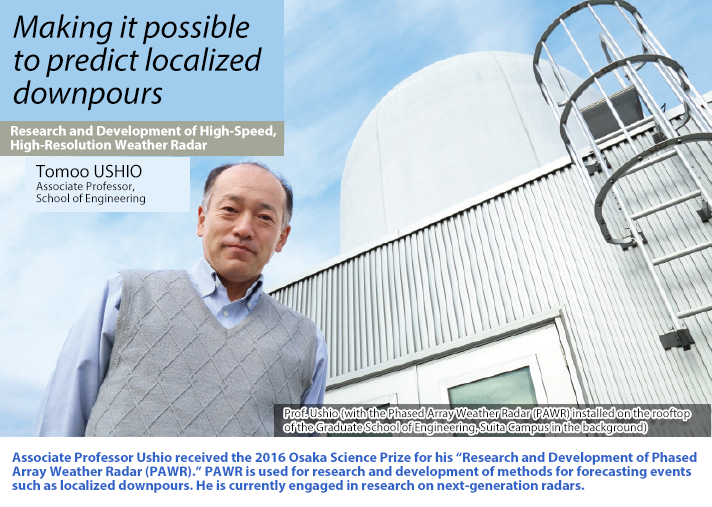
Making it possible to predict local heavy rainfalls -- Research and Development of High-speed and High-resolution Weather Radar
Clarification of atmospheric phenomena has made early prediction and warnings of severe weather possible
In recent years, sudden local downpours and tornadoes causing severe damage are on the rise. The PAWR system can observe detailed three-dimensional rain distribution at a resolution of 100 meters every 10 seconds. Unlike conventional parabolic-antenna radars, PAWR, with its 128-slotted array antenna, does not require one to physically rotate the antenna many times. The digitally-controlled antenna enables the three-dimensional measurement in the 60km-radious radar range at 15km height within 30 seconds. (Previously it took 5-10 minutes.)” As mechanisms behind the generation of atmospheric phenomena are further clarified and their signs are more correctly detected, it will be able to provide quick weather forecasts and warnings in the future.

Continuous observation of local heavy rainfall from its start (condensed water) to end
The PAWR system was completed in 2012 on the rooftop of the Graduate School of Engineering on the Suita Campus. Prof. Ushio says, "Cumulonimbus clouds that bring heavy rainfall rapidly develop in about ten minutes. The process in which a heavy rainfall area formed in well-developed cumulonimbus clouds and fell to the ground while changing was observed as a continuous video every 30 seconds."
These results drew much attention because they lead to disaster prevention measures such as alerts and evacuation orders. Verification experiments of the system started as part of a Cabinet Office project and a severe weather prediction method was developed by using “K” supercomputer at RIKEN and radar observation data by PAWR.
The joy of believing in future possibilities supported his research
Initially, Prof. Ushio was engaged in research on lightning discharge in the United States. He says, "Cumulonimbus clouds produce lightning, but weather instruments such as lightning detectors and devices for observing formation and structures of cumulonimbus clouds have different temporal resolutions, so detailed analysis was not possible when data were collated. I was keenly aware of the need for a high-resolution radar, so I shifted to my current research theme."
In order to show the potential of his research to the world, he produced a high-resolution radar by hand with his students and presented research results at academic conferences. It was hard to do research on a limited budget in the beginning. He said, "We believed in the potential of our research and were fully involved in it. Just like the characters in the novel Saka no Ue no Kumo *, we looked only towards the future. Such enjoyment enabled us to overcome our difficulties."
*Saka no Ue no Kumo [Clouds above the Hill] is a historical novel written by SHIBA Ryotaro, a graduate of the Osaka School of Foreign Languages, which is now the School of Foreign Studies at Osaka University.
The important thing is to believe in yourself and be honest with yourself
Currently, Prof. Ushio is studying next-generation 'polarized phased array weather radars' that are capable of accurately predicting precipitation by accurate estimation of droplet sizes. "I’m convinced that the combination of weather forecast know-how of the Meteorological Agency, significantly advanced computational performance, and data from our high-speed and high-resolution radar, will drastically advance the quality of weather forecasts in the near future."
His belief is to "believe in myself and be honest with myself." To current students at Osaka University, he gives advice, saying, "If you try to do something new, you may be objected by many. But if you don’t find the courage to give your idea a try, you cannot get results. After listening to opinions from others, you should give priority to your idea and put forth serious effort."


Tomoo USHIO
A 1993 graduate from the Faculty of Engineering, Osaka University, Prof. Ushio completed the doctoral program at the Graduate School of Engineering, Osaka University in 1998. (Doctorate in Engineering) In the same year, he became a researcher at the Marshall Space Flight Center, National Aeronautics and Space Administration (NASA). In 2000, he became an assistant at the Graduate School of Engineering, Osaka Prefecture University. He has held his position as an associate professor at the School of Engineering, Osaka University since 2006.